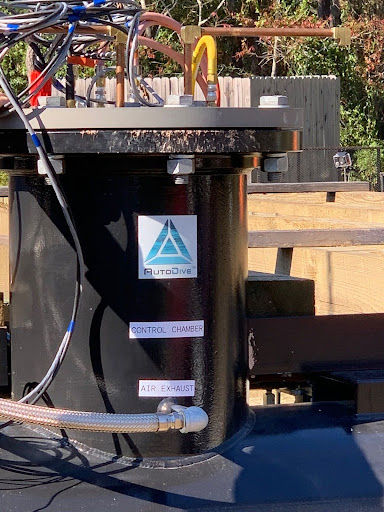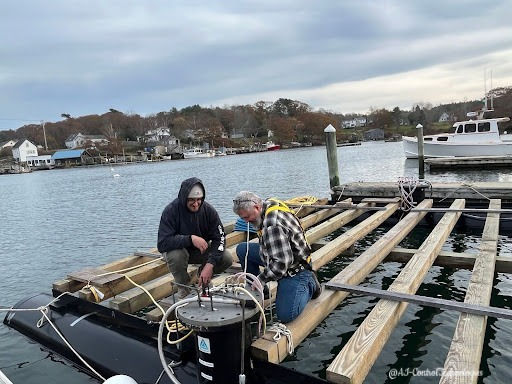“We are a Blue Tech company that provides turnkey equipment to shellfish farmers, transforming grower economics using automation.” - Chris Webb - CEO - AI Control Technologies
Shellfish farming methods date back to bed-grown cultures, where farmers began with a mother shell and set it on the ocean floor. Once those briny creatures reached harvest, they were net dredged, shipped back to the docks, and sent to market. Historically, you might see bed-grown shellfish on the shorelines. Still, more often than not, shellfish farmers use oyster grow-out bags on stands on shorelines in intertidal areas or floating cages, with up to six bags further out (see AUTODIVE® Trials Raft below), and in all cases, managing them is by hand.
Climate change is upon us, and for some shellfish farmers, the search for newer and less labor-intensive technologies allows access to better ocean environments and nutrient streams. All this forces discussion around moving offshore, into deeper waters, but still near shore. Reduced exposure to near-shore turbulence and higher seas offshore will require more durable and accurate equipment to address inclement weather and protect crops and equipment over time.
AI Control Technologies Company Background
Scientists from Harvard and MIT have been testing robotics, AI, and Smart Systems to empower more mechanized ocean farming processes for at least a decade. The USDA’s campaign “Aquaculture is Agriculture” has opened up grants and professional access to shellfish growers, supporting economic development and providing opportunities to test new technologies. To that end, a new company emerged from the research and design of building mechanized aquaculture systems, AI Control Technologies, based out of Ocean Springs, Mississippi. By the end of 2028, their objective is to deliver over 2,000 ropeless, submersible, autonomous shellfish rafts to the ocean farming industry.
Chris Webb, President, founded AI Control Technologies; his team includes Alan Hamilton, COO; Tim Matuszewski, CRO; Stephen Clark McCarty, Product Manager; and Clay Culbert, Installation and Maintenance Manager. Together with a skilled advisory board of shellfish subject matter experts, they are working to build a program to support, manage, and control aquaculture rafts from a centralized system onshore. The advisory board consists of Ted Maney, a shellfish biologist and ocean farmer; Christopher Davis, PhD New England Shellfishing Industry Leader and oyster farmer; and Frank Lyman, who has a fisheries microbiology qualification and electronics manufacturing background.
Shellfish Monitoring During Production
When growing safe and healthy shellfish, monitoring water temperature salinity, acidity, turbidity, wave heights, and logging nutrient streams is key to developing marketable bivalves in the supply chain. Today, data loggers and sophisticated weather analysis exist in agriculture. That said, the ability to pivot in food production can be limiting. What if a seawater temperature rises and the ocean farmer has the ability to adapt by simultaneously diving their stock into 10-15 meters of colder waters? Monitoring and changing the vectors in any food business can be difficult in real-time.

Environmental Issues When Considering Platforms of Scale
The days of using forestry notebooks to log data will never end, and it’s okay because every ocean farmer uses the “best way” for them to handle running their business. Developing and customizing systems to more accurately manage ocean farming data has already been done, using products that capture temperature trends and gather tidal data, which is on point. Some family farmers don’t have the scale to address recordkeeping at a more costly level. Others have built a sustainable market for themselves and choose to maintain legally compliant records while investing in manufacturing and supply chain development.

Next Gen Shell Fishing
Moving shellfish nearshore requires automated solutions that run platforms of scale to house both the shellfish and technology itself. This requires buoyancy and balance while running on cloud-based solutions using high-end mobile devices, like your phone or tablet or surface vessel handheld control unit. Chris and his team designed and launched the AUTODIVE® platform, an end-to-end technology system on a 21-foot-long by 8-foot-wide system, offering a sustainable approach to scaling without increasing labor costs.

The system has stacked, secured cages and a depth charge component designed like a scuba system, with the flexibility of surface de-foul at night or during more stable surface conditions. Sinking the structure underwater, mitigating surface bacterial risk, and minimizing predator exposure, while addressing new nutrient streams at lower depths could lead to deeper cup sizes, flavor profiles, and safer shellfish overall. The equipment design addresses the elimination of certain flora and fauna in the environment. AUTODIVE® solves depth control challenges with patented underwater technologies that emulate natural ocean and manual processes necessary for seafood production. Then, using machine learning, the technology learns and replicates the farmer’s preferential depths and movements (2024, Webb, C.).

Case Study
Atlantic Aqua Farms is North America’s largest grower and processor of widely recognised, high-quality Prince Edward Island Mussels under the brand name Canadian Cove, as well as premium oysters and clams.
Situation: Shellfish farmers are managing the uncertainty of onshore ocean farming and climate change. Atlantic Aqua Farms is seeking to scale from 36,000 oyster bags, with 6 bags in each floating cage (see Figure 3 floating cage image below) in production to over 120,000 bags while maximizing the use of technology.
Challenge: Growing a shellfish business in little-used deeper water, circa 20ft, leased sites, still near shore, tapping into new nutrient streams without adding excess labor and operation costs.
Solution: Jeff MacPherson, CFO of Atlantic Aqua Farms, partnered with AI Control Technologies and ordered three AUTODIVE® oyster raft systems for delivery in Spring 2024.
Each raft can hold up to 240 oyster bags vis, only 6 bags for each current floating cage. Therefore, the new 84,000-bag deployment (or 120,000 total planned—36,000 existing) will require only 350 rafts rather than 14,000 floating cages, where each cage must be serviced and harvested manually. The resulting reduction in labor and labor-associated operating expenses will transform farmer production economics, profitability, and market competitiveness.
Success: Atlantic Aqua Farms, with oyster farms in PEI and Maine, New England, continues to partner with AI Control Technologies for scalability and technology applications in shellfish expansion.
AI Control Technologies' broader mission in the US is to facilitate the expansion or scaling of the US oyster industry to become a net exporter.

Customer Panel
Chris and his team are building momentum with several shellfish producers in North America. They are working with Ward Aquafarms, . Oyster Bay, Pemaquid Oysters, and finally, Undine Marine, to name a few.
Investor Panel & Grant Development
AI Control Technologies is working not only on large-scale investor and USDA Grant opportunities but also with an investor pool of investors like the Harvard Business School Alumni Angel Fund (HBS Boston) and Innovate MS Mississippi, both of whom have signed a Letter of Intent (LOI) to invest. Chris and the team have also just applied for a $300,000 USDA 2024 grant to add through-the-water acoustic communication functionality to AUTODIVE® controlled rafts.
Key Association Relationships
The team has contacted over 6,000 shellfish farms and is building relations with industry associations like Alaska, The East Coast, and the Pacific Coast Shellfish Growers Associations. For more information about AI Control Technologies or Chris Webb, click the link to Foraging and Farming!




Comments